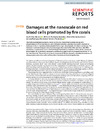Please use this identifier to cite or link to this item:
https://accedacris.ulpgc.es/jspui/handle/10553/114248
| DC Field | Value | Language |
|---|---|---|
| dc.contributor.author | Diaz-Marrero, Ana R. | en_US |
| dc.contributor.author | Gonzalez, MCR | en_US |
| dc.contributor.author | Creus, AH | en_US |
| dc.contributor.author | Rodríguez Hernández, Adriana | en_US |
| dc.contributor.author | Fernandez, JJ | en_US |
| dc.date.accessioned | 2022-03-29T12:53:51Z | - |
| dc.date.available | 2022-03-29T12:53:51Z | - |
| dc.date.issued | 2019 | en_US |
| dc.identifier.issn | 2045-2322 | en_US |
| dc.identifier.uri | https://accedacris.ulpgc.es/handle/10553/114248 | - |
| dc.description.abstract | The hydrocoral Millepora alcicornis, known as fire coral, biosynthesize protein toxins with phospholipase A2 (PLA2) activity as a main defense mechanism; proteins that rapidly catalyse the hydrolysis at the sn-2 position of phosphatidylcholine-type phospholipids of cellular membranes. This hydrolysis mechanism triggers a structural damage in the outer leaflet of the red blood cells (RBC) membrane, by generating pores in the lipid bilayer that leads to a depletion of the cellular content of the damaged cell. A secondary mechanism, tentatively caused by pore-forming proteins toxins (PFTs), has been observed. The use of atomic force microscopy (AFM) has allowed to visualize the evolution of damages produced on the surface of the cells at the nanoscale level along the time. | en_US |
| dc.language | eng | en_US |
| dc.relation | CTQ2014-55888-C03-01-R | en_US |
| dc.relation | INTERREG-MAC/1.1b/042 | en_US |
| dc.relation | Seguimiento, control y mitigación de proliferaciones de organismos marinos asociadas a perturbaciones humanas y cambio climático en la región Macaronésica | en_US |
| dc.relation.ispartof | Scientific Reports | en_US |
| dc.source | Scientific Reports [ISSN 2045-2322], v. 9, 14298 | en_US |
| dc.title | Damages at the nanoscale on red blood cells promoted by fire corals | en_US |
| dc.type | info:eu-repo/semantics/article | en_US |
| dc.type | Article | en_US |
| dc.identifier.doi | 10.1038/s41598-019-50744-6 | en_US |
| dc.identifier.pmid | 31586105 | - |
| dc.identifier.scopus | 2-s2.0-85072910142 | - |
| dc.identifier.isi | WOS:000489011000006 | - |
| dc.contributor.orcid | 0000-0002-8886-7519 | - |
| dc.contributor.orcid | #NODATA# | - |
| dc.contributor.orcid | #NODATA# | - |
| dc.contributor.orcid | #NODATA# | - |
| dc.contributor.orcid | 0000-0002-0805-8317 | - |
| dc.identifier.issue | 1 | - |
| dc.investigacion | Ciencias | en_US |
| dc.type2 | Artículo | en_US |
| dc.utils.revision | Sí | en_US |
| dc.identifier.ulpgc | Sí | en_US |
| dc.contributor.buulpgc | BU-BAS | en_US |
| dc.description.sjr | 1,341 | |
| dc.description.jcr | 3,998 | |
| dc.description.sjrq | Q1 | |
| dc.description.jcrq | Q1 | |
| dc.description.scie | SCIE | |
| item.grantfulltext | open | - |
| item.fulltext | Con texto completo | - |
| crisitem.project.principalinvestigator | Acosta Arbelo, Félix Antonio | - |
| crisitem.author.dept | GIR ECOAQUA: Biodiversidad y Conservación | - |
| crisitem.author.dept | IU de Investigación en Acuicultura Sostenible y Ec | - |
| crisitem.author.orcid | 0000-0002-2785-4458 | - |
| crisitem.author.parentorg | IU de Investigación en Acuicultura Sostenible y Ec | - |
| crisitem.author.fullName | Rodríguez Hernández,Adriana | - |
| Appears in Collections: | Artículos | |
SCOPUSTM
Citations
5
checked on Jun 8, 2025
WEB OF SCIENCETM
Citations
4
checked on Jun 8, 2025
Page view(s)
65
checked on Apr 27, 2024
Download(s)
35
checked on Apr 27, 2024
Google ScholarTM
Check
Altmetric
Share
Export metadata
Items in accedaCRIS are protected by copyright, with all rights reserved, unless otherwise indicated.
